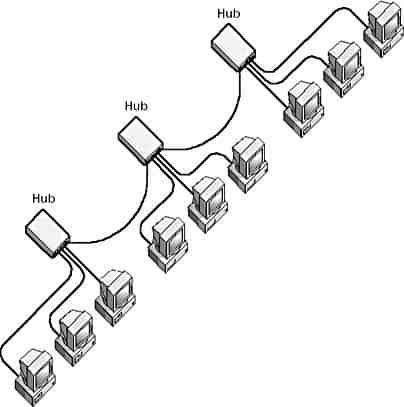
Star Topology Diagram Software Gives You
SmartDraw network topology software gives you presentation-quality results every time. Automatic network connectors allow you to focus on your design and documentation rather than worry about drawing a diagram. SmartDraw provides quick-start network topology templates that put the right symbols at your fingertips.
Active hubs contain repeaters, while passive hubs are considered non-intelligent nodes.Star topology is known to have a single point of failure, and if the network topology was to be a hybrid of a star topology joining together other star topologies, there would still be a single. The hub can be active or passive in nature. Star Topology is the kind of network topology in which all the nodes are connected via cables to a single node called a hub, which is the central node. Identify the network topology from below diagram presented below:Peer-to-Peer, Star Topology Diagram Requirements: Depict a star topology in the diagram Position the central hardware network communications device that.3.
Each computer or server is connected to the single bus cable. Physical topology refers to the placement of the networks various components, including device location and cable installation, while logical topology shows how data flows within a network, regardless of its physical design.Distances between nodes, physical interconnections, transmission rates, and/or signal types may differ between two networks, yet their topologies may be identical.In local area networks where bus topology is used, each node is connected to a single cable. A reliable topology where the devices are interconnected and data is transmitted by.Network topology is the physical arrangement of the various elements (links, nodes, etc.) of a computer network.Essentially, it is the topological structure of a network, and may be depicted physically or logically. A common topology for larger networks. The crucial difference between star and ring topology is that the star topology is suitable for a primary-secondary type of connection whereas ring topology is more Star topology. Star and Ring topology are the types of network topologies.

When a device sends data, it must travel through each device on the ring until it reaches its destination. Each device incorporates a receiver for the incoming signal and a transmitter to send the data on to the next device in the ring.The network is dependent on the ability of the signal to travel around the ring. The primary disadvantage of the star topology is that the central point represents a single point of failure.A network topology that is set up in a circular fashion in which data travels around the ring in one direction and each device on the ring acts as a repeater to keep the signal strong as it travels. An advantage of the star topology is the simplicity of adding additional nodes. The central point acts as a signal repeater.The star topology is considered the easiest topology to design and implement. The network does not necessarily have to resemble a star to be classified as a star network, but all of the nodes on the network must be connected to one central device.All traffic that traverses the network passes through the central point.

A two-node network is technically a fully connected network.The type of network topology in which some of the nodes of the network are connected to more than one other node in the network with a point-to-point link – this makes it possible to take advantage of some of the redundancy that is provided by a physical fully connected mesh topology without the expense and complexity required for a connection between every node in the network.The other options presented are not valid.


 0 kommentar(er)
0 kommentar(er)
